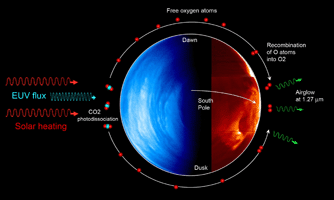 The upper atmosphere of Venus has no clouds but it can be "visually" observed through airglow phenomena associated
with particular molecules. The most intense of these airglows is the molecular oxygen airglow. The image on the left
shows VIRTIS observations of oxygen airglow which is displayed on the figure as a tenuous "ghost-like" cloud in blue.
Venus Express observations of these phenomena help to understand the chemistry of the upper atmosphere and its dynamics.
The upper atmosphere of Venus has no clouds but it can be "visually" observed through airglow phenomena associated
with particular molecules. The most intense of these airglows is the molecular oxygen airglow. The image on the left
shows VIRTIS observations of oxygen airglow which is displayed on the figure as a tenuous "ghost-like" cloud in blue.
Venus Express observations of these phenomena help to understand the chemistry of the upper atmosphere and its dynamics.
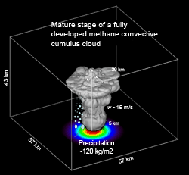 An intense methane convective cumulus simulated in Titan. From: "Methane storms in Saturn's moon Titan", R. Hueso and
A. Sánchez-Lavega, Nature, 442 (2006).
An intense methane convective cumulus simulated in Titan. From: "Methane storms in Saturn's moon Titan", R. Hueso and
A. Sánchez-Lavega, Nature, 442 (2006).Figure in Spanish (figura en español).
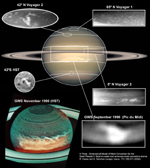 Comparison of different types of convective
activity observed in Saturn from 1980 to 2003 before the Cassini arrival to the planet. Figure published in
A Three - Dimensional Model of Moist Convection for the Giant Planets II: Saturn's water and ammonia moist convective storms.
R. Hueso and A. Sánchez-Lavega, Icarus, 172, 255-271 (2004).
Comparison of different types of convective
activity observed in Saturn from 1980 to 2003 before the Cassini arrival to the planet. Figure published in
A Three - Dimensional Model of Moist Convection for the Giant Planets II: Saturn's water and ammonia moist convective storms.
R. Hueso and A. Sánchez-Lavega, Icarus, 172, 255-271 (2004).
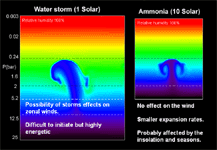 Comparison of Equatorial storms in Saturn made of water and ammonia.
Both calculations assume 1 solar concentration of the condensables and very favorable conditions for storm development,
including a relative humidity of 99%.
Comparison of Equatorial storms in Saturn made of water and ammonia.
Both calculations assume 1 solar concentration of the condensables and very favorable conditions for storm development,
including a relative humidity of 99%.
 Figure Caption:
Low resolution animation of a large convective storm system as viewed
by the Voyager 1 in 1979.
High resolution films of this and other similar events can be downloaded
here.
Figure Caption:
Low resolution animation of a large convective storm system as viewed
by the Voyager 1 in 1979.
High resolution films of this and other similar events can be downloaded
here.A detailed analysis of this cloud feature is given on the article: A Model for Large Scale Convective Storms in Jupiter. Hueso, R., A. Sánchez-Lavega and T. Journal of Geophysical Research: Planets, 10, DOI: 10.1029/2001JE001839, (2002)
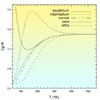 Hydrogen Cp as a function of temperature. Some odd effects that modify the thermal structure of cold
giant planets atmospheres.
Hydrogen Cp as a function of temperature. Some odd effects that modify the thermal structure of cold
giant planets atmospheres.
 General mechanisms operating in protoplanetary disks including planetary formation
General mechanisms operating in protoplanetary disks including planetary formation(Legends only in Spanish). More information can be found in the article published by the Spanish Association of Astronomy (SEA)
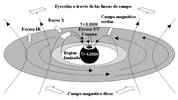 Mechanisms operating in the inner part of protoplanetary disks.
Mechanisms operating in the inner part of protoplanetary disks. (Legends only in Spanish).
More information can be found in the article published by the Spanish Association of Astronomy (SEA)